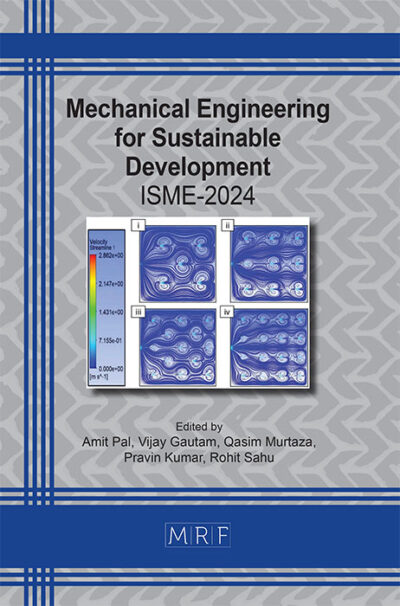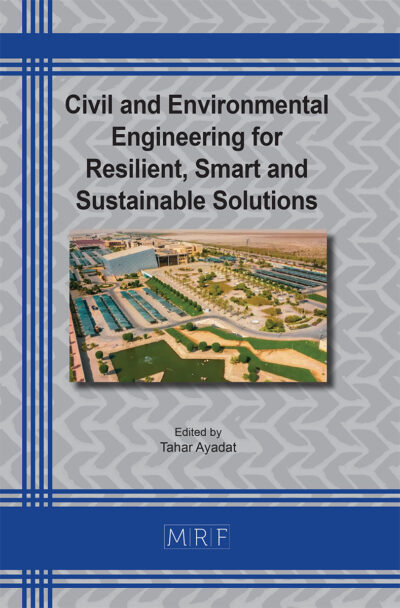Roads failure and sustainability challenges of Zambian roads: A review of current practice
Nathan Ntanda CHILUKWA, Mohamed Mostafa Hassan MOSTAFA, Christopher NGWIRA
Abstract. Significant investments have been made in the past ten years to improve the road network in Zambia. Programs initiated by the Government, such as the Link 8000 and L400, among others, aimed at constructing and rehabilitating more than 10, 000 km of roads at an estimated cost of over US$ 31 billion. However, as the programs progressed, it was noticed that some roads were failing before their design period (premature failure), calling into question the durability of the constructed roads and whether value for money was attainable. The problem is attributable to a wide range of factors. In the quest to achieving sustainability in the sector, all steps in the implementation process of roads construction must be interrogated to identify factors contributing to failure and curtail their impact. In this regard, this paper reviews some of the design practices and decisions for roads in Zambia. The paper reviews Terms of Reference (ToRs) and pavement structural designs for some road projects distributed all over Zambia to highlight challenges and inadequacies with the currently applicable standards and design guidelines. The treatment of uncertainties in design inputs and integration of sustainability concepts is also explored and benchmarked with regional and international best practice. Recommendations are presented to improve decision making during the roads design process.
Keywords
Zambia, Premature Failure, Pavement Design, Durability, Sustainability
Published online 2/25/2025, 10 pages
Copyright © 2025 by the author(s)
Published under license by Materials Research Forum LLC., Millersville PA, USA
Citation: Nathan Ntanda CHILUKWA, Mohamed Mostafa Hassan MOSTAFA, Christopher NGWIRA, Roads failure and sustainability challenges of Zambian roads: A review of current practice, Materials Research Proceedings, Vol. 48, pp 988-998, 2025
DOI: https://doi.org/10.21741/9781644903414-107
The article was published as article 107 of the book Civil and Environmental Engineering for Resilient, Smart and Sustainable Solutions
![]() Content from this work may be used under the terms of the Creative Commons Attribution 3.0 license. Any further distribution of this work must maintain attribution to the author(s) and the title of the work, journal citation and DOI.
Content from this work may be used under the terms of the Creative Commons Attribution 3.0 license. Any further distribution of this work must maintain attribution to the author(s) and the title of the work, journal citation and DOI.
References
[1] Programme for Infrastructure Development in Africa (PIDA). North-South Multimodal Transport Corridor. (2022). Available at: https://www.au-pida.org/view-programme/21/ (Accessed: 9 May 2022)
[2] Road Transport and Safety Agency (RTSA). Annual Report. (2020). Available at: https://www.rtsa.org.zm/wp-content/uploads/2021/09/2020-RTSA-Annual-Report-v5-FINAL-EDITED.pdf (Accessed: 23/06/2022)
[3] Mwila F. A Comparative Study of Access to Railways in Zambia Relative to Road Transport. Master’s Degree Dissertation. (2016). Available at: http://dspace.unza.zm/bitstream/handle/123456789/4772/Main%20Document.pdf?isAllowed=y&sequence=1 (Accessed: 23/06/2022)
[4] Raballand, G., Kunaka, C. & Giersing, B. The Impact of Regional Liberalization and Harmonization in Road Transport Services: A Focus on Zambia and Lessons for Landlocked Countries. The World Bank, Africa Transport Department. (2008). DOI: 10.1596/1813-9450-4482
[5] Mutumweno N. Zambia launches Link Zambia 8000 road project. African Review of Business and Technology. (2012). Available at: http://www.africanreview.com/construction-a-mining/roads/zambia-launches-link-zambia-8000-project. Accessed 30 June 2020
[6] Chilukwa, N. and Lungu, R. Determination of Layers Responsible for Rutting Failure in a Pavement Structure. Infrastructures, 4, 29. (2019). https://doi.org/10.3390/ infrastructures4020029 Accessed 09 April 2020.
[7] Malunga R., et al. Theoretical Review of Different Asphalt Mix-Design Methods and their Applicability for Developing Countries like Zambia. Geo-Hubei 2014 International Conference on Sustainable Civil Infrastructure. (2014). DOI: 10.1061/9780784478462.026
[8] Mwanza, A. D. Modelling of Rutting Prediction for Flexible Pavements in Zambia. Dissertation for Doctor of Philosophy, Chang’an University, China. (2008).
[9] Mwanaumo E. M. and Sakala E. Planning and Designing Standard of Rural Road Construction – An Exploratory Study: A Case of Lusaka Province In Zambia. Journal of Construction Project Management and Innovation, 11(1): 79-90. (2021). ISSN 2223-7852. Sustainable Human Settlement and Construction Research Centre.
[10] Okikbo, K. Causes of Highway Failures in Nigeria. International Journal of Engineering Science and Technology (IJEST), Vol. 4 No. 11. (2012). ISSN: 0975-5462
[11] Wirtgen, Gmbh. Wirtgen Cold Recycling Technology. 1st Edition. Wirtgen, Gmbh. (2012).
[12] Road Development Agency (RDA). Low Volume Roads Manual Volume 1-Pavement Design. Ministry of Housing and Infrastructure Development. (2019). ISBN: 978-9982-70-970-5
[13] South African National Roads Agency (SANRAL). South African Pavement Engineering Manual (SAPEM)- Pavement Design. (2014). ISBN 978-1-920611-10-1
[14] Wazoh H. N., Daku S. S., Samuel F. G. Investigative Study of Possible Causes of Failure of A Section of Road in Jos-Plateau, North -Central Nigeria. 2. 2458-925. Journal of Multidisciplinary Engineering Science Studies (JMESS). (2016). ISSN: 2458-925XVol. 2
[15] Pais, J. C., Amorim, S. I. R., and Minhoto, M. J. C. Impact of Traffic Overload on Road Pavement Performance. ASCE Journal of Transportation Engineering, 139(9), (2013) 873-879.
[16] Savio D., Nivitha M. R., Bindhu B. K., Krishnan J. M. Overloading analysis of bituminous pavements in India using M-EPDG. 11th Transportation Planning and Implementation Methodologies for Developing Countries, TPMDC 2014, 10-12 December (2014), Mumbai, India. doi: 10.1016/j.trpro.2016.11.115
[17] Oh, J. H., Chen, D. H., Walubita, L. F., & Wimsatt, A. J. Mitigating seal coat damage due to superheavy load moves in Texas low volume roads. Construction and Building Materials, 25(8), 3236-3244. (2011).
[18] Leiva-Villacorta, F., Vargas-Nordcbeck, A., Aguiar-Moya J.P. and Loría-Salazar, L. Influence of Tire Footprint Area and Pressure Distribution on Pavement Responses. Springer International Publishing Switzerland. (2016). DOI 10.1007/978-3-319-42797-3_45
[19] Prozzi, J.A. and Luo, R. Quantification of the Joint Effect of Wheel Load and Tire Inflation Pressure on Pavement Response. Transportation Research Record: Journal of the Transportation Research Board, No. 1919, pp. 134-141. (2005). DOI: 10.3141/1919-14
[20] Lee, S. I., Mwanza, A. D., Mutembo, G., & Walubita, L. F. Effects of Tire Inclination on the HMA Pavement Shear Stress-Strain Response: 2-D Computational Modeling. In Design, Analysis, and Asphalt Material Characterization for Road and Airfield Pavements (pp. 41-48). (2014).
[21] Hu, X., Faruk, A. N., Zhang, J., Souliman, M. I., & Walubita, L. F. Effects of tire inclination (turning traffic) and dynamic loading on the pavement stress–strain responses using 3-D finite element modeling. International Journal of Pavement Research and Technology, 10(4), 304-314. (2017).
[22] Zapata C. E., Andrei D., Witczak M. W. and Houston W. N. Incorporation of Environmental Effects in Pavement Design. (2007). DOI: 10.3166/RMPD.8.667-693
[23] Paige-Green P. A Reassessment of Some Road Material Stabilization Problems. Proceedings of the 27th Southern African Transport Conference (SATC 2008) 7 – 11 July 2008. Pretoria, South Africa. ISBN Number: 978-1-920017-34-7
[24] Valle P. D and Thom N. Reliability in pavement design. 6th Eurasphalt & Eurobitume Congress. Prague, Czech Republic. (2016). DOI: dx.doi.org/10.14311/EE.2016.033
[25] Lee et al. Texas flexible pavements and overlays: interim report for phases ii and iii—data collection and model calibration. Technical report. (2017). Available at: http://tti.tamu.edu/documents/0-6658-2.pdf (Accessed: 23/04/2022)
[26] Walubita et al. Texas flexible pavements and overlays: year 1 report – test sections, data collection, analyses, and data storage system. Technical report. (2012). Available at: http://tti.tamu.edu/documents/0-6658-1.pdf (Accessed: 08/04/2020)
[27] Walubita et al. Texas flexible pavements and overlays: year 5 report—complete data documentation. Technical report. (2017). Available at: http://tti.tamu.edu/documents/0-6658-3.pdf (Accessed: 08/05/2020)
[28] Southern Africa Transport and Communications Commission (SATCC). Code of Practice for the Design of Road Pavements. Division of Roads and Transport Technology, CSIR. (1998).
[29] Transport Research Laboratory, Overseas Road Note (ORN) 31. A guide to the structural design of bitumen-surfaced roads in tropical and sub-tropical climates. Overseas Centre, TRL, Crowthorne, Berkshire, UK. (1993). ISSN 0951-8797
[30] Diogo, J.F.R., Shubber, A.A.M., and Lin, M.H. Design Methodologies of Asphalt Pavement Used in China and Mozambique. Journal of Applied Sciences 7(9), (2007). 1333-1338.
[31] Technical Recommendations for Highways, TRH4. Structural Design of Flexible Pavements for Inter-urban and Rural Roads. Committee of Land Transport Officials (COLTO). Department of Transport, Pretoria, South Africa. (1996).
[32] Shallal, D. M., & Ahmed, E. S. A Comparison between the Empirical and Mechanistic-Empirical Pavement Design Methods. International Journal of Scientific Research and Management, 7(07), 261–267. (2019). https://doi.org/10.18535/ijsrm/v7i7.ec01
[33] American Association of State Highway and Transportation Officials (AASHTO). Guide for design of pavement structures. (1993). Available at: https://habib00ugm.files.wordpress.com/2010/05/aashto1993.pdf (Accessed: 26 June 2022).
[34] Jones D. The Development of SATCC Standard Specifications and Design Guides for Roads and Bridges. 21st Annual South African Transport Conference. South Africa, (2002). ISBN: 0-620-28855-8
[35] Jordaan G. and Kilian A. The cost-effective upgrading, preservation and rehabilitation of roads – optimising the use of available technologies. Proceedings of the 35th Southern African Transport Conference. (2016). ISBN Number: 978-1-920017-64-4
[36] Retherford J. Q. Management of Uncertainty for Flexible Pavement Design Utilizing Analytical and Probabilistic Methods. Dissertation for PhD. Vanderbilt University. (2012). Available at: https://core.ac.uk/download/pdf/216051318.pdf (Accessed: 31 August 2022)
[37] Pinard M. I. Emerging good practice in overload control in Eastern and Southern Africa – selected case studies. Sub-Saharan Africa Transport Policy Program. (2011). Available at: https://www.ssatp.org/sites/ssatp/files/publication/DP12-Overload-Control-Case-Studies.pdf (Accessed: 13 April 2020)
[38] Phiri J. Overloading on the Copperbelt – A Classic Case of Misplaced Priorities. Daily Nation. (2020). Available at: https://www.pressreader.com/zambia/daily-nation-newspaper/20201217/281689732408227 (Accessed: 01/08/2022)
[39] Tripartite Transport and Transit Facilitation Programme (TTTFP). Country Baseline Report – Zambia. (2017). Available at: https://tttfp.org/wp-content/uploads/2019/06/Zambia-Final-Report-1Feb17.pdf (accessed: 15 August 2022)
[40] Kim D. Super-single tire loadings and their impacts on pavement design. Canadian Journal of Civil Engineering. 35(2): 119-128. (2008). https://doi.org/10.1139/L07-090
[41] Wang F. Mechanistic-Empirical study of effects of truck tire pressure on asphalt pavement performance. Dissertation in partial fulfillment of the requirements for the degree of doctor of philosophy. Graduate school of the University of Texas at Austin. (2005). Available at: https://repositories.lib.utexas.edu/bitstream/handle/2152/2357/wangf31903.pdf (Accessed: 08 April 2020).
[42] Breytenbach, I J, Paige-Green, P, & Van Rooy, J L. (2010). The relationship between index testing and California Bearing Ratio values for natural road construction materials in South Africa. Journal of the South African Institution of Civil Engineering, 52(2), 65-69. (2010). Available at: http://www.scielo.org.za/scielo.php?script=sci_arttext&pid=S1021-20192010000200008&lng=en&tlng=en. (Accessed: Aug. 3, 2022)
[43] Haupt, F J, & Netterberg, F. Prediction of California Bearing Ratio and compaction characteristics of Transvaal soils from indicator properties. Journal of the South African Institution of Civil Engineering, 63(2), 47-56. (2021). https://dx.doi.org/10.17159/2309-8775/2021/v63n2a6
[44] Southern African Development Community (SADC). Guideline: Low volume sealed roads. SADC House, Gaborone. (2003). ISBN 99912-0-456-3
[45] Ebels L. J. Characterisation of Material Properties and Behaviour of Cold Bituminous Mixtures for Road Pavements. Dissertation for Doctor of Philosophy, Stellenbosch University. (2008). Available at: https://core.ac.uk/download/pdf/37319064.pdf (Accessed: 23/06/2022)
[46] Walubita L. F., Liu W., and Scullion T. The texas perpetual pavements: experience overview and the way forward. Technical report. (2010). Available at: http://tti.tamu.edu/documents/0-4822-3.pdf (Accessed: 26/04/2022).
[47] Walubita L. F., Hoeffner J., and Scullion T. New generation mix-designs: laboratory-field testing and modifications to texas hma mix-design procedures. Technical report. (2013). Available at: http://tti.tamu.edu/documents/0-6132-3.pdf (Accessed: 26/04/2022).
[48] McSweeney, C., New, M. & Lizcano, G. UNDP Climate Change Country Profiles: Zambia. (2010). Available: http://country-profiles.geog.ox.ac.uk/ (Accessed 10 May 2022).
[49] Abejide S. O. Stress Intensity Failure Rate Propagators of Flexible Pavement. Dissertation for PhD. Central University of Technology. (2020).
[50] Samson A. O. and Abimbola O. T. An Investigation into Early Road Failure in Nigeria: Mechanistic Analysis of Road Note 31. IJNREAS. (2014). Available at: file:///C:/Users/User/Downloads/AN_INVESTIGATION_INTO_EARLY_ROAD_FAILURE.pdf (Accessed 10 June 2022).












